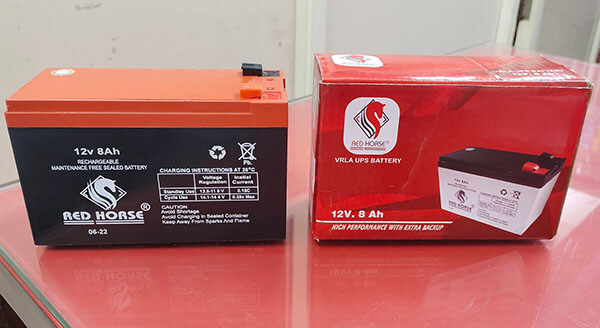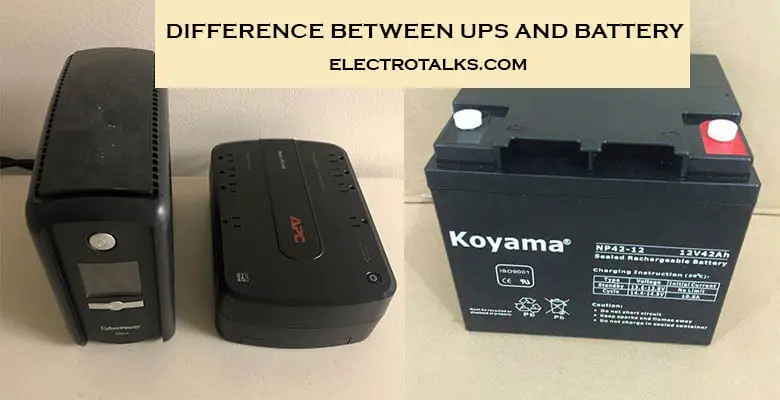“As an Amazon Associate, I earn from qualifying purchases. Without Any Extra Cost to You!”
Someone who is well into household activities. Especially if you’re the electrician of the family, then you are aware of all the things that need to be done by yourself as well as those things that are required to be done by a professional. It is quite normal to be confused over what is a UPS and battery.
Based on all the electric devices you are using, you will need them for particular purposes, and both will work as a backup. You may think that both are the same things, but that is not the case as they have significant differences. I have had a friend who struggled quite a few times because of the proper usage of these two devices.
I will guide you about these two in multiple steps so that you find the utmost clarity!
What is what? UPS and Battery
Before going through the critical differences and necessities of each of those devices, let me first tell which device is which, along with their types.
UPS (Uninterruptible Power Supply)
An Uninterruptible Power Supply is a hardware device that lets your device run during power outages, voltage spikes, or electricity fluctuations. This device, in general, lets you protect your work and data and gives you enough time to save or restore it. There are, in general, three types of UPSs. Based on the ones you may use, let us go through the types.
Double Conversion UPS system
Generally known as online ups systems, these are also called double conversion UPS systems because they are capable of converting Alternating Current (AC) to Direct Current (DC) along with DC to AC. It provides a smooth flow of electricity without any such lags, unlike the other two types. It is significantly better than the other UPS systems as it protects you from all kinds of distortions, including sine wave issues. The most powerful devices that have the highest level of data use the Double Conversion Online UPS system. Also, of the other two, this one is the most expensive.
Line Interactive UPS system
This is where you start to filter things out based on what you need. The line interactive UPS system is less powerful than the Online UPS but better than the Offline UPS because of its ability to handle voltage fluctuations and power conditioning. You are supposed to purchase a line interactive UPS system when your location doesn’t exactly electricity cut but instead has many arrays of voltage up and downs.
The line interactive UPS system is competent to hand multiple waves of voltage fluctuations. It barely takes around five milliseconds for the UPS to switch to its battery backup when there are voltage fluctuations or power drops. An inverter is used in a line interactive UPS and is used as the output. It can be used to charge the UPS as well as have it as battery support during breaks.
Offline UPS System
You probably own an Offline UPS System if it’s something at your home or your office’s desktop. An offline UPS system is the cheapest of them all and is used by all types of generic people just for the primary safety of their device as well as their work. It will protect you against most power cuts and voltage spikes but might get damaged if there are an abnormal amount of voltage fluctuations.
Its usage is for a lower range of devices and isn’t meant to handle large servers that need full-time surveillance. An offline UPS system contains an inverter that lets the DC current gets converted to AC current since most devices have alternating current. Conversion is a necessity. There is around a 9-millisecond of gap when the electricity gets transferred to the battery backup of the UPS.
Battery Backups
These devices are their offline ups system or just even minute devices that simply let your devices run for the sake of it not getting ruined. This device also consists of an inverter where it flows DC currents and then converts them to AC current for the devices.
Battery backups safeguard devices such as laptops, computers, mobile phones, external hard drives, gaming consoles, or even Routers for smooth internet connection. Just like the offline UPS, battery backups also take around 8 to 9 milliseconds to transition to it battery power.
Battery backups are vaguely used in many as all of these power devices require a battery inside, which can be told as battery backup so that we get a smooth flow of electricity without any such interruptions. A battery could be required for vehicles and other electronic devices that are not relevant to battery backups which we are talking about.
What is the difference between UPS and Battery backup?

Now let us go through the key differences between the devices so that you find your clarity in understanding and deciding which one you should purchase. I have created a small chart so that you find simplicity in understanding everything. My job is to make it easy for you.
| Remarks | UPS | Battery |
| Define | A hardware device that comes in many shapes based on the types and provides backup power to any form of electricity fluctuations. | A device that provides battery backup to devices that are homely more often than not and protects those devices from general voltage spikes and electricity cuts. |
| Circuit | Could Inverter or Rectifier based on the types. | Inverter |
| Electricity Conversion | AC to DC, DC to AC, and Both | DC to AC |
| Types | Three types: Double Conversion, Line Interactive, and Offline UPS | Battery Backup Device |
| Power Duration | Offline UPS is 10-15 mins on average, Line Interactive UPS is around 50 mins, and on Double Conversion UPS, it varies. | For Battery backup, it is mostly 5 to 10 mins. |
| Voltage Spikes | Double Conversion and Line Interactive are able to handle all types of voltage spikes, but Offline UPS cannot. | Can handle most of the voltage spikes that are faced in your household but the absurd up/downs. |
| Utility and Customers | Professional and Personal usage based on the types. | Personal users and for small office work. |
| Devices | Company Servers, High tech computers, and other high-tech devices. | Household general devices such as phones, desktop computers, laptops, and portable hard drives. |
Which one is for you?
Now that you have known which is exactly which device, along with their critical disparities. So, if you are someone who is in desperate need of a battery backup for your desktop personal computer, then I recommend getting either an offline up with a backup time of around 10-20 mins or if you want to go for a cheaper alternative, then get those small battery backup devices that provide 5-10 mins worth of backup.
Or, if you’re someone who is the tech head of a company and you need power as a backup for your brand’s servers, then surely you should get a Double Conversion Online UPS system as it will protect your data and the devices from all costs and electronic calamities. Line Interactive comes as a middle ground because it deals with all kinds of fluctuations in voltages. It is better than Offline UPS but not the Double Conversion UPS.
Additional: Are you talking about CBS (Central Battery System)?
You clearly may be wondering what exactly is a Central Battery System when you are trying to know the differences of those two. Well, a CBS is entirely from a UPS and a Battery Backup. A Central Battery System is the ultimate backup device that lets your emergency lights and devices turn on during accidents or certain abnormalities.
When there are accidents or massive circuit bursts that completely cuts off the electricity from all compartments. The central battery system bypasses all these fluctuations and turns on the emergency lights and alarming noise.
Yes, that is right if you’re in the factory and hear emergency red lights turned on along with the loud noises, it actually comes from the central battery system. The CBS backup has to go through multiple legal correspondences to have it fit for the factory.
FAQs (Frequently Asked Questions)
What is the difference between IPS and UPS?
An IPS is denoted as an instant power supply, and a UPS is denoted as an uninterruptible power supply. Both provide backup and have certain distinctions in sizes, devices, and backup times. IPS is more prominent in size than the UPS and is more resistant to handling multiple devices. In the case of inverters, for UPS, it is turned on during there’s an electricity cut, but when it comes to IPS, it is turned on to power the batteries inside of it.
Can an inverter work as a UPS?
Well, it can be said in such that all inverters can be UPSs, but all UPSs cannot be called inverters. Inverters can be used as a UPS for your small electronic devices. Some inverters even have a mode called UPS mode. Both supply electricity as backup during an outage but their functionalities are quite different.
How long do an offline UPS last if it is regularly used?
If used properly, then you can last offline ups for five years and 3-4 if average. Bear in mind that you need to charge it wisely, as the more you charge it, the faster you reduce its lifespan. Your UPS will either be unusable, or you will need to change the batteries.
Wrap Up!
Choosing a UPS isn’t precisely challenging work, but knowing the details and the specific disparities of the devices can be bothersome, and that is where I have assisted you today. I genuinely enjoyed explaining to you all the details there are when it comes to UPS and battery backups.
In many phases of our life, we will surely encounter different battery backups such as IPS, UPS, Inverter, and Generators and will be in need of buying one or a few of them at some point in our lives.
But, right now, for your home, you should as well get the offline UPS as it is more than enough to deal with your electricity fluctuating home. And, for other minute devices, a portable battery backup should be enough as those devices won’t be that affected, unlike your work computer.
Thus, I hope you have enjoyed my insights and will help others so that they don’t find issues in understanding the two.
